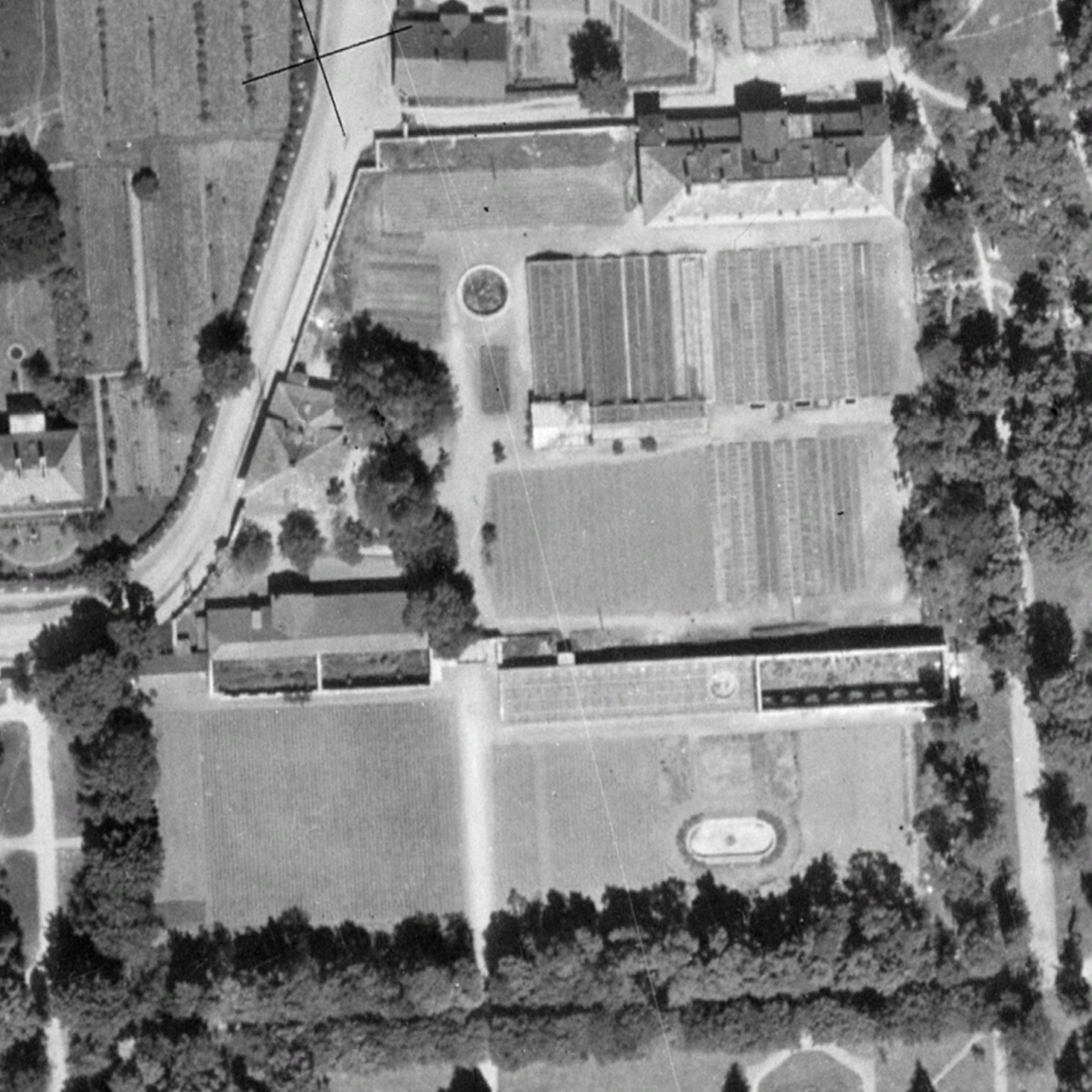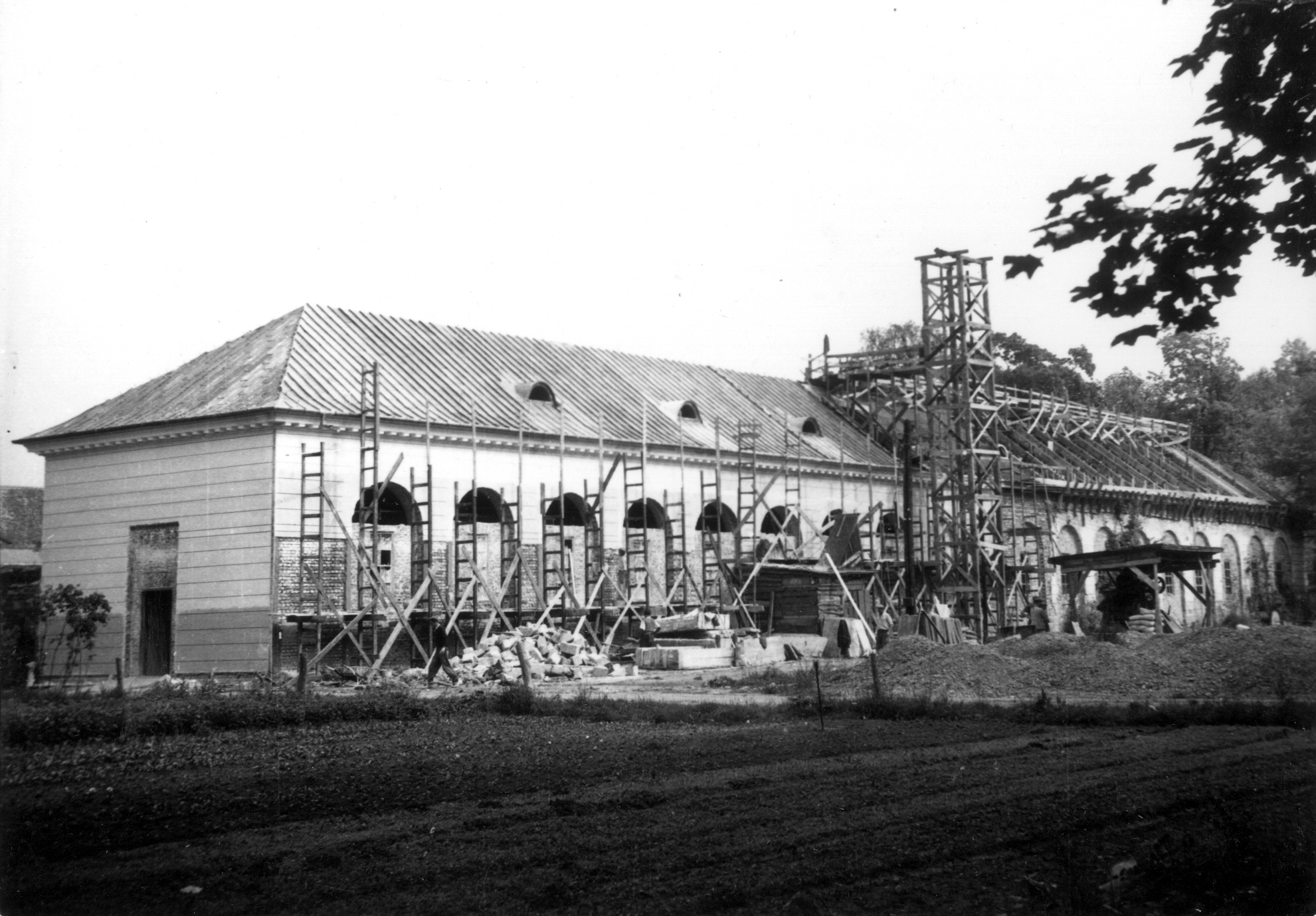
On 28 January 1945, Wilanów Palace was nationalized and became a branch of the National Museum in Warsaw, led first by Jan Morawiński (1945–1949), then by Wojciech Fijałkowski (1954–1991), and Teresa Pocheć-Perkowska (1991–1995). Although all measurement plans, historical materials, and designs prepared by Gerard Ciołek had burned in the Krasiński Library (now the National Library of Poland in Warsaw) during the Warsaw Uprising, the author managed to partially restore them based on his surviving notes and sketches. In the years 1946–1951, the garden underwent its first significant maintenance, which consisted in the construction of a water-and-sewage network and pathways, regulating the embankment, planting new trees, and reconstructing Baroque parterres. Owing to severe financial limitations and staff shortages, however, it was not possible to maintain the results of these efforts. What is more, the old garden and hothouse area was handed over to the Warsaw University of Life Sciences, thus preventing the production of decorative plants for the park. In 1948, the ruins of the orangery and the surviving architectural details were catalogued by architects Stanisław Cynarski and Bolesław Janulis.
On 18 December 1954, the Presidium of the Council of Ministers passed a resolution on the general restoration of Wilanów as a unique monument of Polish history and art culture for the purposes of establishing a museum and representing the State. Conservation work was supervised by architect Stefan Deubel (1954–1959), and then Jacek Cydzik (1959–1967). However, on 15 April 1955 the Central Investment Projects Evaluation Committee of the National Planned Economy Commission practically halved the funds for Wilanów restoration and struck park and park architecture restoration off the conservation task list. Nevertheless, the destroyed orangery was fully rebuilt between 1956 and 1960. The work was carried out by the National Workshop for Monument Conservation in Warsaw based on the designs prepared by architects Stefan Deubel and Jan Bolesław Bieńkowski. The building was restored to its early-nineteenth-century condition. Surviving fragments helped reconstruct the portico with Korynthian columns, and the sculpted façades and interior details. The roof, originally made of wood shingle, was replaced with copper sheet metal, a reference to the Old Orangery in the Royal Łazienki Park. Interior layout and function were modified. The remnants of the nineteenth-century fountains were removed and the main hall was adjusted to serve as an exhibition hall. The floor covering was made of clinker brick. The western part of the orangery was furnished with a staircase and an elevator leading to an attic where museum exhibits were stored. The orangery also gained a small cellar for firewood. The northern façade acquired a new transverse wing, with a central heating boiler room and residential premises for boilermen. Orangery cubature grew to an impressive 8,995 m3, making it the second largest building in the entire complex, surpassed only by the Palace itself. The rebuilt fighouse, which also fell prey to World War II, acquired a new form which referred to the shape of the old stables building adjoining it from the north. The restored fighouse housed the furniture conservation studio and gilding workshop.
In 1959, following the request submitted by the Government Committee, appointed by Deputy Prime Minister Piotr Jaroszewicz to investigate work progress in Wilanów, it was possible to hire more full-time gardeners (before that, Wilanów had only one permanent member of gardening staff!) and reclaim the Wilanów gardens from the Warsaw University of Life Sciences. Once again it was possible to grow decorative and exotic plants in the existing hothouse. At the time it occupied some 900 m2 and consisted of a brick boiler room (surviving to this day) and six iron-framed chambers (rooms) from the pre-war period. In 1970s an additional greenhouse was built, with an area of 280 m2. At first, only several species were introduced back to the Palace gardens, including American aloe (Agave americana), Canary Island date palm (Phoenix canariensis), and Lawson cypress (Chamaecyparis lawsoniana), displayed in wooden pots of natural colour. The collection of citruses and exotic plants was not the priority back then, given the constant staff and financial shortages, and other urgent revival works, such as the reconstruction of Baroque parterres, tree preservation, pathway reconstruction, cleaning of water bodies, and the revival of statues and architectural objects. In the 1980s, the pre-war greenhouses were demolished, and three new ones were built in their place, each 40 metres long and 10 metres wide. This provided almost 1,500 m2 to grow greenhouse plants.
Citruses could not be found in Wilanów gardens for two reasons: space for growing them was initially unavailable, and it was not possible to acquire citrus trees. Plant growers weren't interested in them, considering them to be unprofitable. Prof. Szczepan Aleksander Pieniążek from the National Institute of Horticultural Research in Skierniewice was the first to take up this issue. In 1967, he received four saplings of the ‘Ponderosa’ dwarf lemon from Dr Alec Gudziak, a Canadian scientist of Polish descent from the Manitoba University in Winnipeg. Upon return from his 1973 trip to China, where he saw citruses grown at homes as decorative plants, Professor Pieniążek propagated the citruses at hand. Appreciating their nutritional and medical values, he decided to popularize them in Poland. After having grown 4,000 saplings, he distributed some across the country for further propagation. Several plants were also sent to the greenhouses in Wilanów. The lemon attracted significant media publicity, and was dubbed the “Skierniewice lemon”. Two papers by Prof. Pieniążek on citruses were published in 1977 and 1992. In these works, he synthetically described their history, growing and propagation methods, and thoroughly discussed their morphological details. Among the most commonly grown species, he listed: sweet (Citrus sinensis) and bitter orange (Citrus aurantium), trifoliate orange (Poncirius trifoliata), mandarin orange (Citrus reticulata), lemon (Citrus limon), lime (Citrus aurantifolia), grapefruit (Citrus paradisi), pomelo (Citrus grandis), citron (Citrus medica) and pearl (Fortunella margarita) and Japanese kumquat (Fortunella japonica).
Under socialist rule, when Poland had a planned economy, citruses became luxury goods. In general, they only appeared in Polish households at Christmas. Sweet oranges and grapefruit (with sugar) were served as dessert fruit, and lemon was mostly added to tea and certain fruit-and-vegetable salads as seasoning. Fruit was shipped mainly from Cuba and delivered to stores to demonstrate the “generosity of state authorities”. Poor quality, small size, tangible fibres, and sour taste prompted Poles to coin the name “Cuban oranges”. Owing to the severe economic and political crisis, the 1980s saw a nation-wide upturn in citrus tree cultivation. They practically were not imported to Poland back then, so their price and the profitability of cultivation grew notably. As coal and energy prices soared, many growers decided to switch from cultivating flowers and vegetables to growing citruses. The fall of communism and introduction of market economy brought foreign fruit back to Polish shops. Their wide availability, combined with significantly reduced purchasing power of Poles, rendered citrus cultivation unprofitable again. Trees were kept only for decorative purposes and as botanical specimens.

A 1995 ordinance of the Minister of Culture and Science established Wilanów Palace as a unit separate from the National Museum in Warsaw. Since 1995, the Wilanów Palace has operated as an independent cultural institution. A year later, then Director of the Wilanów Museum Wojciech Fijałkowski listed [...] the introduction of citrus and laurel trees in pots, and the flowers used in the Baroque period to the decorative offer of the garden [...] as one of the priorities for the upcoming years. This concept took 15 years to be implemented. In 2006, the Wilanów garden area was decreased in size by one third to enable expanding the garden by the former St. Alexander’s Hospital. Old greenhouses were demolished and replaced with a new storage house (9x24 m), and a greenhouse with five chambers and a connector (14x45 m) which exist to date. They provide a total of around 890 m2 for growing exotic plants.
8 May 2009 witnessed the launch of the Citrus Adoption Club aiming to engage visitors in Museum activities, foster integration through meetings, and enrich the Wilanów citrus collection. Anyone willing to nurture a citrus plant received a sapling. Volunteers were to take care of the plants for two years, and then return the grown specimens to the Museum. In 2012, the Museum welcomed trees from another edition of the programme. The initiative found caretakers for 235 trees brought to Wilanów from Italy. These were: calamondin (Citrofortunella microcarpa), sweet orange (Citrus sinensis), common lemon (Citrus limon), grapefruit (Citrus paradisi), common fig (Ficus carica), key lime (Citrus aurantifolia), pomegranate (Punica granatum), and trifoliate orange (Poncirus trifoliata). The Finale of the Citrus Adoption Club took place on 7 September 2013, and most of the adopted trees returned to Wilanów.
Between 2009 and 2011, the Museum revitalized the regular gardens surrounding the Palace based on the concept designed by Prof. Zbigniew Myczkowski. Revitalisation helped restore orange trees in wooden plank pots to the garden, ten tree-shaped calamondins (Citrofortunella microcarpa) to the Rose Garden, and 14 bitter oranges to the Baroque Garden (Citrus sinensis). In 2015, on the initiative of Łukasz Przybylak and Kamila Domańska who ran the Garden Department, white and green striped pots returned to Wilanów, reconstructed based on the exquisite vedute by Bernardo Bellotto, an Italian painter also known as Canaletto. In the pots, Wilanów gardeners Stefan Pluta and Sylwester Sender planted 34 bitter oranges (Citrus sinensis) and four common lemons (Citrus limon) imported from Sicily. Currently, the exotic plant collection comprises 368 plants of 74 species and varieties, including 101 citrus specimens. These are: five calamondins (×Citrofortunella microcarpa), five bitter oranges (Citrus aurantium), 29 common lemons (Citrus limon), one grapefruit tree (Citrus paradisi), 13 mandarin oranges (Citrus reticulata), and 48 sweet oranges (Citrus sinensis), including four of the Washington Navel variety. In 2016, work on developing a concept for adapting the orangery interior was initiated. Window joinery was replaced and new interior shutters were installed.

In order to continue the reconstruction of the citrus collection, the Museum initiated cooperation with the Uffizi Gallery in Florence under the “Citri et Aurea” project. The diplomatic relations between the court of King Jan III and the Grand Duke of Tuscany Cosimo III form the historical grounds for this alliance. The Boboli Gardens, managed by the Italian museum, hold a unique citrus collection with species and varieties from the Medici era. Exchanging knowledge and experience in collection gathering and cultivation will enable restoring the historical resources of the Wilanów orangery. The target collection size is 320 trees of historical species and varieties, grown in oaken pots painted in white and green stripes (200) and of natural colour (72), as well as 24 in ceramic enamel pots and 24 in Delftware vases.
I kindly thank Łukasz Przybylak and Nela Kokoszka for their help in creating the source base for this article.
Translated by Katarzyna Bartkowiak
This article has been written as part of the “Citri et Aurea” project carried out in cooperation with the Uffizi Gallery – the Boboli Gardens in Florence, under the patronage of the European Route of Historic Gardens.

We would like to inform that for the purpose of optimisation of content available on our website and its customisation according to your needs, we use information stored by means of cookies on the Users' end devices. You can control cookies by means of your Internet browser settings. Further use of our website without change of the browser settings means that you accept the use of cookies. For more information on cookies used by us and to feel comfortable about this subject, please familiarise yourselves with our Privacy Policy.
✓ I understand